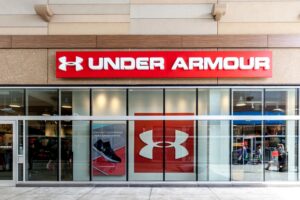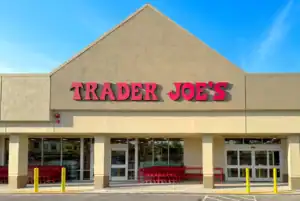
©Prostock-Studio via Canva.com
October 17, 2024
How Might the Grocery Price Wars Affect Consumers in the Long Term?
As the fast-food industry continues its price wars, expanding into competition with restaurants, another industry has begun its own battle. A new era of grocery price wars has purportedly begun.
All of this comes on the heels of rising grocery prices brought about by inflation and various socio-economic factors. And if the matter continues to escalate, then the grocery price wars are a “potential game-changer,” according to Forbes.
Walmart dominates the U.S. grocery market, holding around 25% of annual grocery spending. The company recently cut prices on thousands of essential items, a move that comes after a 6% revenue increase in 2023, highlighting its strategy to attract price-conscious consumers.
In contrast, Kroger, the second-largest supermarket operator, has lost market share for three consecutive years, dropping to 10.1% last year. Despite its efforts to merge with Albertsons, Kroger continues to face challenges in maintaining customer loyalty and competitiveness.
Target, with grocery revenue of only $23.9 billion in 2023 and a market share of 2.7%, has also struggled. However, in May, it announced that it was cutting the prices of 5,000 products throughout the summer in order to help lessen the burden of inflation while attempting to lure back wary customers.
ALDI has made multiple moves to compete in the grocery price wars recently, first by cutting prices over the summer and now by claiming to offer the cheapest Thanksgiving value meal ahead of Walmart. The grocery retailer claims its Thanksgiving bundle is cheaper than it was in 2019 and can feed up to 10 people for less than $47.
Costco has also entered the grocery price wars this month by cutting prices on various Kirkland Signature products, including a 13% reduction on boneless chicken tenderloins. In its recent Q4 and fiscal year 2024 report, the company announced net sales of $78.2 billion, a 1% increase year-over-year, with total annual sales reaching $249.6 billion, up 5%. Additionally, Costco plans to open a new mixed-use warehouse in Baldwin Village, South Los Angeles, featuring residential apartments above the retail space, which will include affordable housing and create around 400 local jobs.
To get in on the action, Amazon recently launched a budget grocery brand amid the price wars, according to Geek Wire. Its new private-label grocery brand, “Saver,” aims to increase its share in the grocery market and compete more fiercely with Walmart and Target. This budget-friendly line offers a range of food items designed for cost-conscious shoppers.
The introduction of Saver aligns with a growing trend among retailers to prioritize affordability in response to intense price competition. As Walmart, Target, and others pursue aggressive pricing strategies, Amazon’s move could further reshape the grocery landscape, emphasizing value without sacrificing quality.
However, grocery retailers might take things too far. According to USA Today, Congresswoman Rashida Tlaib has accused Kroger of potentially using technology that could enable surge and discriminatory pricing. In a letter posted on social media, she expressed concerns that electronic shelf labels (ESLs) could allow Kroger to implement dynamic pricing during emergencies, raising the cost of essential goods based on real-time conditions and inventory. Tlaib warned that this could create confusion and hardship for consumers in areas with limited grocery options. She also highlighted the risks of facial recognition software, suggesting it could lead to biased pricing and invade customer privacy.
In response, Kroger denied these allegations, asserting that its technology aims to lower costs for consumers and stating, “Kroger does not and has never engaged in ‘surge pricing.’”
Back in 2019, Kroger tested cameras embedded in price signs on shelves in suburban stores in Cincinnati and Seattle. These cameras aimed to estimate shoppers’ gender and age, but the company stated that no data was stored, as reported by The Counter at the time. Additionally, in 2017, Coca-Cola set up endcaps in 250 grocery stores that connected to shoppers’ smartphones, allowing the ads to update dynamically based on demographic data from their Google profiles.
According to Grocery Dive, Ahold Delhaize stores in the Netherlands are utilizing ESLs to reduce food waste by dynamically lowering prices. These price adjustments are based on AI-driven predictions about a product’s remaining shelf life, encouraging customers to purchase items before they expire.
Discussion Questions
How might the escalation of the grocery price wars influence long-term consumer behavior, particularly in terms of brand loyalty and perceived value among different income groups?
In what ways do advancements in technology, like electronic shelf labels and dynamic pricing, challenge traditional retail ethics regarding consumer privacy and fair pricing?
As Amazon and Costco introduce budget-friendly options, what implications could this have for smaller grocery chains and local markets struggling to compete?
Poll
BrainTrust
David Naumann
Marketing Strategy Lead - Retail, Travel & Distribution, Verizon
Lucille DeHart
Principal, MKT Marketing Services/Columbus Consulting
Lisa Goller
B2B Content Strategist
Recent Discussions







The days of hefty food price rises are, thankfully, behind us. While grocery and foodservice prices are not going to revert to where they were in 2019, we are now entering an era of more intense price competition. This is mostly because on the demand side, consumers have reacted to rising prices by cutting volumes, shopping around more, and trading down. Retailers, restaurants, and CPG brands are alert to this and are responding with lower prices in a bid to protect market share. I am not sure we will have a completely deflationary market, but there will be more scope to keep a lid on food expenses over the next year or so.
Despite what politicians tell us about price gouging and other simplistic falsities, supermarkets make very small margins after costs.
Although “price wars” make good headlines, and they may even influence politics a bit, at least artificially right before an election, supermarket chains are not buying goods at lower prices, and warehouse inventory bought many weeks ago was purchased at inflationary prices.
Sooner or later, supermarkets will have to increase prices again to make their normal margins.
Prices won’t adjust longer term until external factors, such as gas and energy prices, interest rates, supply chain corrections, and improvements in the real economy, are corrected.
As this article rambled all over the place, I’m not sure which question to answer; but I think I’ll go with the titular one: there won’t be any long term affects as these price wars are temporary. Perhaps the most important – tho not new – tidbit was this: Target, with grocery revenue of only $23.9 billion in 2023 and a market share of 2.7%. so why, again, do we devote so much space to Target’s girly man grocery efforts ?
Food is a commodity. We have to eat, so we are a captive audience. But the grocers can only go so far. Consumers are anchored on what prices used to be, so every increase feels like a blow. Which means that grocery chains should be prepared for blowback…fewer purchases, trading down on brands and types of food (pasta in lieu of beef), and value decisions (organic vs. non, processed vs. whole foods).
This category has a lot of trickle-down implications. You can put off a haircut, but you can’t stop eating. You can forego restaurant meals, but you still have to feed yourself & your family & pets. Groceries are a mainstay in every household budget, but we can’t forget that grocery stores are for-profit businesses & every escalated cost in the supply chain just gets passed along.
These grocery price reduction programs are a direct result of consumers squirming in the face of unreasonable price hikes at their local store. Retail companies should take these small revolts seriously.
Lower prices will always be welcomed by shoppers and the grocers that have the lowest perceived price cuts, while maintaining quality, will be the winners. Price competition is great for consumers. Regarding electronic shelf labels (ESLs) leading to surge pricing to take advantage of consumer demand, I don’t “buy” it. The objective of deploying ESLs is not to exploit vulnerabilities in consumer demand, it is more about labor savings and more accurate price consistency between the shelves and POS.
Grocery price wars are conditioning us to be more conscious of value for money. Retailers are working hard to win our big baskets.
Private label launches like Amazon’s Saver line and Walmart’s bettergoods add affordability, quality and exclusivity to their assortments, which can drive loyalty.
More grocers have added deals and coupons to their mobile apps, rewarding customers for shifting online. Grocers also gain a unified view of the customer by combining their online and in-store activities and loyalty points when shoppers scan their mobile app at the checkout.
Recognizing the concerns and circumstances surrounding our economy, all retailers are looking for ways to improve efficiencies, rationalize assortment, and reduce costs to effectively lower consumer prices. Grocers and pharma companies have certainly been under attack of late.
I think the measures to introduce aggressive pricing will be appreciated by shoppers. However, grocers’ margins are already low and relying on technology to tip the scales seems a slippery slope. My fear is that we could spiral into a race to the bottom wherein service will suffer, in-stock conditions diminish, and shopper experience becomes non-existent.
This is a textbook case of “a race to the bottom.” Grocers cannot win long-term by just being the lowest price–Walmart owns that market. They need to differentiate themselves with private label and curated offerings by holiday/season/culture–much like Trader Joes that has build a fan base purely on their brand. In turn, the lowest prices are not a formula for profitability. Target and Walmart can use grocery as loss leaders to drive store traffic and frequency, but true sole purpose grocers cannot. Dynamic pricing is not and should not be banned, nor abused. Knowing what and when and to whom to offer certain price levels is what drives profitability. Contrary to those who think CPG and grocers are only price gauging are missing the point. Grocers operate on a 2% margin at best and are the end of the food supply chain which is impacted by regulations, more expensive envitronmental regulations, energy prices and increasing labor costs. While I’d love to buy a steak for $12 again, it is not feasible in the state of inflation we are in.
In a price war, the customer wins. But keep in mind, the war isn’t really about the price. It’s about keeping the customer. And customers who are price-conscious will gravitate to the grocery store that offers the lowest price.
If it were me, I’d be competitively priced – not necessarily the lowest – and deliver a level of service that makes price less relevant. That helps insulate the retailer from price wars and holds onto the customer.
Grocers have been under pressure by the government and consumers to continue downward pricing in the wake of recent inflation and shoppers looking for more deals.
Brand loyalty can play some role into sensitivity for shoppers in a trade area who define ‘low prices’ as their biggest motivator in selecting a store. But shoppers have other primary motivators as well, like ‘quality’, ‘convenience’, ‘variety’, ‘selection’. For those customers, getting a deal is good, but brand loyalty will be more driven by the overall experience, product availability, good service and cleanliness.
The effect of the grocery price wars will be to prompt shoppers to buy more store brands, which offer good quality and prices that are always lower than national and regional brands.
I am fascinated by the results of the poll – it reinforces the three key imperatives surrounding “price wars”… it’s still about (1) product quality and selection, (2) customer experience and satisfaction, (3) brand reputation and corporate practices.
There are many reasons Grocery margins are typically razor thin, and one of the major ones is in many parts of the aisles price is the ONLY thing that matters. Sure organic is probably better for you, but how do you prove that?
A price work helps consumers, period. Whether or not it fosters loyalty is, IMO very difficult to prove.